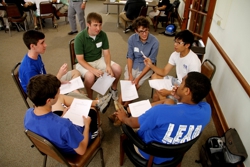Over the six semesters I have been teaching the Art of Storytelling, I have had three classes with deaf students. I sign a little, but thankfully the college provided two interpreters for each class. They were all wonderful as they interpreted for the deaf students, and also voiced for them when they performed a story.

So it was only natural that when I got a case of laryngitis that I thought, “No problem, I will just get an interpreter to come in and ‘voice’ for me.” I E-mailed the disabilities department and asked how much lead time they needed. Unfortunately, the supervisor wrote back that they only provided interpreters for the students, and I would have to contact HR. So I did.
The HR Department wrote back that laryngitis does not comply with the definition of an ADA disability and that if I were sick, I needed to contact my department head and arrange for a sub. I replied that I was disappointed and that, “I’m not ill. I don’t need a sub, just a voice.”
Step two, get creative!
I wondered what I could do. I have a small P.A. system and tested it out. I whispered into the mike, and it seemed that the amplification would work.
Now the lesson plan…
In the first class, we spent time learning about each other We went around the circle and everyone told their name and what they wanted to get out of the class. I told a personal story that helped the students learn more about me, and showed them what a story could do.
This was the second day of class, an altogether different animal. Today was the day that we would take the hour and fifteen minutes to go over the syllabus. I had learned from a colleague that this was important so students could understand what was expected of them, and exactly what they were getting into. The syllabus was like a “contract” between them and me. It was important to understand all the parts of it.
I have changed my syllabus over the course of the past two years. It has gotten longer with each semester, as the students kept asking more questions about the course, the assignments, where to find things, etc. I believe it is now fairly complete. It has every piece of information on the entire course. So complete, in fact, that when a student now asks a question, I can confidently say, “It’s in the syllabus.”

The only problem is that the syllabus is now
nine pages long! My usual strategy was to sit and read through each section and then ask, “Does everyone understand? Are there any questions?” This was usually followed by the mindless shaking of heads as if all the students were mimicking those little dogs on the dashboard or the back shelf of a car that continually bobbed their heads. That is, of course, if they had not fallen asleep during my reading. At the least, as the hour progressed, I would see eyes glazing over and rolling into the backs of their heads!
Step three: get more creative. Even whispering for 75 minutes would be a challenge for me. Plus, I hated this day more than any other in class, but felt it was necessary. My friend and fellow teacher, Carl, kept telling me things like, “Let the students do the work.” I kept responding, “No, they won’t understand it. I need to tell them what’s what!” Boyoiyoiyoiyoing! (Yeah, that’s how students learn!)
So I got more creative. I thought, let’s do something different. It couldn’t be any worse than me droning on and on about what’s in the course. Plus I thought, “This is STORYTELLING class, let’s have them tell stories.” (Duh.)

I broke them up into small groups, and had each group focus on a different section of the syllabus. They had ten minutes to discuss the section and decide how they could “tell a story” so everyone would understand the section. Could they do it? Perhaps it was too soon in the course. Would they know how to TELL a story? I waited, and didn’t talk for ten minutes.
As a therapist, the most important thing that I learned and tried to do was to “trust the process.”
This time, in this class, I did, and the students came up with the most creative stories and innovative ways to tell them. AND… then the class then gave each group appreciations! And it was a LOT more fun than me droning on. I was overjoyed, and everyone had fun too.
Hopefully, I learned a lesson here. Number one, let them do the work, that’s how they learn. Two, Let them use STORY to demonstrate what they learned. Yikes, pretty simple, eh? OMG, why did it take me so long to get smart? Why did it take laryngitis for me to figure it out? I guess it was really quite symbolic. I had to stop asking those kids in the corner to stop talking and be quiet. What I really needed to do... to be a better teacher... was to just close my mouth, and stop talking!